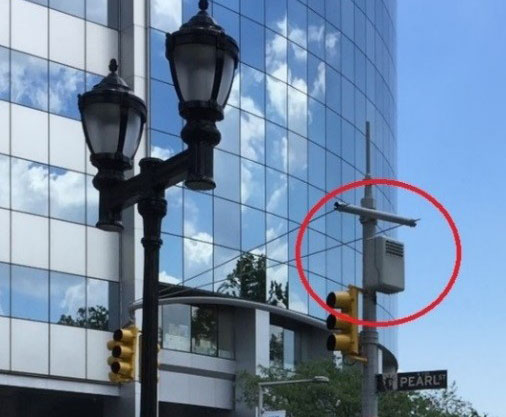TELECOM LEADERS PUSH FOR HIGH-SPEED WIRELESS
BY BENJAMIN FANG
Business leaders and telecommunications companies are pushing city officials to expand high-speed, wireless service throughout the five boroughs.
Traditionally, mobile users get their high-speed Internet from macro sites that are placed on top of buildings. But lately, companies are using “small cells,” radio nodes that are placed on city infrastructure like utility poles, street lights and signs. They use small radios and antennas to provide service and are closer to the ground.
Carriers are employing this technology to meet growing consumer demand for wireless data and uses such as streaming, video conferencing, and even managing operations.
“In a crowded place like New York City, more people are doing more things on more devices,” said Verizon spokesman David Weissmann. “There’s a growing need for more capacity for networks.”
According to Verizon, the demand for wireless data services has doubled in the last year. It’s expected to grow six-fold from 2015 to 2020. The demand puts pressure on the mobile network, telecommunications experts say, forcing companies to come up with new ways to “densify” the network.
Small cells are usually deployed in dense, heavily-populated urban environments. By providing more capacity, networks can serve more people and provide faster service.
Businesses are reliant on fast access to the Internet. Weissmann said companies use wireless technology to upload documents, process credit card transactions, and communicate. Some companies run their entire business on a wireless connection.
“If the Internet speed and connectivity are impacted,” he said, “that would impact their businesses.”
To keep up with the demand, business leaders are pushing the city Department of Information Technology and Telecommunications (DoITT) to let wireless providers and carriers lease the tops of city infrastructure to install the small cell networks.
More specifically, DoITT gives permission for hundreds of lampposts to be reserved, a process that can take up to 15 months.
But according to telecommunications companies, the city agency is restricting expansion below 96th Street in Manhattan to just 25 poles, despite the fact that the need for wireless service is greatest in Midtown. The restriction will likely push expansion to outer boroughs like Queens and Brooklyn, which are also becoming hotbeds of entrepreneurship.
Weissmann said New York City is roughly one year behind to set up the framework to expand small cell network on local infrastructure. “We’ve been expecting it to happen sooner,” he said.
Carriers are currently waiting for the city to release the Request For Proposals (RFP) to apply to become a franchisee, which would allow the businesses to build their own network. Other concerns include having a streamlined approval process and ensuring fair permitting fees.
Experts say small cells are also a stepping stone to 5G technology, the standards for which are being established now.
Weissman said if the foundation for small cells expansion is not created, the city will also fall behind getting to market with 5G. That would also negatively affect the city’s business climate, he said.
“New York City considers itself a tech and innovation hub,” he said. “It can impact the city’s ability to retain tech businesses.”
He said Verizon and other carriers and local businesses are ready for the expansion. They’re just waiting on the city to give the green light. “We’re ready to go,” Weissmann said.


